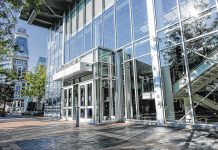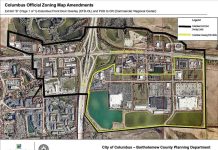The latest schematic design for Columbus’ Riverfront project calls for the low-head dam between Second and Third streets to be removed. However, in-river structures would be added to maintain water levels near Mill Race Park.
The design was unveiled at last week’s Columbus Redevelopment Commission meeting, where Randy Royer, senior principal with Hitchcock Design Group, went over the latest design details.
One of the major components of the project is removal of the low-head dam and the effect that would have on East Fork White River water levels, particularly through Mill Race Park and between the Second and Third street bridges downtown, said Royer, the city’s consultant on the project.
Consultants are proposing up to three in-water structures across the river between the two bridges that would hold the water back enough to maintain water levels, Royer said.
[sc:text-divider text-divider-title=”Story continues below gallery” ]Click here to purchase photos from this gallery
Engineers are working on a design for the structure, which would be modeled, tweaked and modeled again, he said.
The goal is to create a water flow that has some movement to it, but without the forceful flow of a rapids, he said.
“Some people have an image of Rocky Mountain rapids,” Royer said, referring to a photo showing a more placid water scene for kayakers, showing gradual drops through the river passage. “There’s not big white water, but there is some activity,” he said of the water speed.
Consultants also are working to make sure fish can make the passage through the structures, and determining whether three structures are needed, or perhaps only two.
Removing dam
The low-head dam proposed to be removed was installed by the city in 1903 to pool water near the former Columbus Pump House to provide drinking water to the city. Since then, portions of the dam are crumbling and the structure has blocked and caught trees and other debris coming downstream. The pump house, closed for years, has been renovated into the Upland Columbus Pump House, a brew pub on the Riverfront.
The Riverfront project, announced last year, is an effort to improve the area along the river between the Second and Third Street bridges, proposing river overlooks, connections on the People Trail System on the downtown side of the river and a proposed in-water recreation park for kayakers, inner tubing and wading.
Taking out the dam, seen as a danger risk to river users, and installing an in-water recreation park are estimated to cost $2.36 million, while a shoreline stabilization on the east and west banks are estimated to cost $3.47 million, consultants said last year.
Total cost for the entire project has been estimated at $8.6 million in earlier meetings.
City officials expect to fund the Riverfront project through a combination of Tax Increment Financing funds, state and federal grants, and public/private partnerships.
Effect lighting
The schematic design also includes options for lighting, particularly for underneath the Second Street bridge, which now has some graffiti, Royer said.
In a branding initiative, the city could use its Dancing C’s, or the colors that are incorporated there, and take away the blank canvas under the bridge, and instead add some colorful designs and lighting from underneath, Royer said.
“The bridge would be floating on a pillow of light,” he said.
In addition to light there, the People Trail would also have a new lighting pattern so that the light on the bridge and the trail would also reflect on the water, Royer said.
Work would also have to be done for bank stabilization on both sides of the river, with barriers lining the trail along with added landscaping that would allow the community to keep the wooded look that many residents said they preferred for the Riverfront.
While redevelopment commission members seemed receptive to the design proposal, some board members and community residents in the audience questioned the practicality of improving an area that floods multiple times every year, and questioning how much maintenance might be needed to keep the design clean and safe.
Commission member Laurie Booher, who is also a Columbus City councilwoman, said she was all for sitting down along the river to have a cup of coffee and enjoying the ambiance.
“But I still have concern about the kayaking piece,” she said.
Royer said the water recreation area is not just for kayakers. The water would be calm enough for innertubing or paddleboards, a broad-range of family activities.
“For families with children, this will be a safe opportunity to interact with the Riverfront,” he said.
Flooding debris
Community resident Ken Fudge said he was concerned about the ongoing problem of cleaning away debris when the area floods, and the sand that piles up after the water recedes. He wanted to know about the logistics for removing the debris and how much of the landscaping would have to be replaced with each flooding incident.
“One of the biggest problems is that things move in that river,” Fudge said. “Every time you run into a piece of deadfall in the river, it changes the current and creates a dangerous situation,” he said. “There is all kinds of junk flowing down that river.”
Royer said the cleanup after flooding events would be similar to what parks department employees need to do in Mill Race Park, which consists of power washing off the trails and removing debris from roadways.
When Fudge said that most of the cities that have riverfront developments have them with concrete barriers on both banks to prevent debris from entering the river, Royer said he disagrees.
Fudge also said state environmental officials have said E. coli readings for the East Fork White River are elevated upriver and downriver from downtown Columbus and asked what type of water testing, if any, is planned for the project.
Water testing is not being done right now, Pope said, although some testing has already been done by the Sierra Club locally.
Water testing is planned for a time when a design for the project is in place, done over a longer period of time as contamination levels vary from day to day and sometimes minute to minute depending on rainfall, road construction and other factors, Pope said.
[sc:pullout-title pullout-title=”What’s next” ][sc:pullout-text-begin]
The Columbus Redevelopment Commission will receive another status update on the Riverfront project from consultants in October or November. Following that, the city will be able to begin submitting permit applications, according to a timeline provided by the Hitchcock Design Group.
[sc:pullout-text-end]




